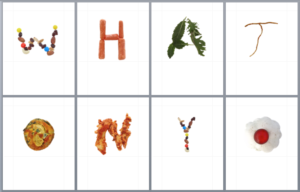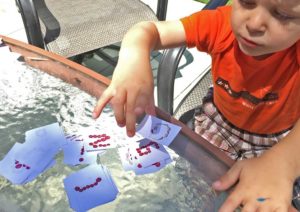There are many ways to use our Printable Food Font Alphabets to support learning the alphabet and to have fun! For younger children the letters can be used to learn and recognize numbers and letters, and for older kids they are great for practicing alphabetical order and expanding vocabulary.
You only need a few simple materials that are easy to pick up at the store to make the alphabet cards, and they can be used for a variety of games and activities.
Educational Benefits:
While playing alphabet games and activities children will learn to:
- Recognize letters of letters
- Listening and memory skills
- Following Directions
- Matching pairs and sorting
 Materials Needed:
Materials Needed:
- Paper to print the food alphabet letters onto (We recommend using white cardstock, but regular paper will do)
- Scissors or Cutting Board
Directions:
- Download one of of the Food Font alphabets that you want to print.(We like Summer Vegetable Alphabet or Summer Veggie food alphabets, but you can also choose your own.) TURN THESE TO 3 INCH
- Print the Food Font alphabet onto white paper or cardstock.
- Cut each letter using either a scissors or cutting board, cutting on the grey outlines. (each letter is a 3 inch square.)
- You now have a set of alphabet letters!
Ideas of how to use Food Font Alphabets:
 Learning the Alphabet
Learning the Alphabet
Print out our alphabets and display it where little ones will see it all the time! You may want to choose lower case letters for the UK, as most children are introduced to these first. Go through the alphabet regularly, pointing to the letters and saying the sounds they make; of course you can also sing the alphabet song!
Alphabet Scramble
Print out a set of alphabet cards and choose a combination, which makes a word appropriate for your child’s age. Scramble them up and have the child put them in the right order. You can make this game more energetic by “hiding” the cards around the room and telling the child how many cards he has to find. It is also a fun team game: use two different sets of alphabet cards and the kids will have great fun running around each other trying to find where their cards are hidden without giving away cards to the other team!
Alphabet Trail
Create a trail of alphabet cards around the room (or house), spelling out a word or short sentence which the child will need to write down in a little notebook and present to you when he reaches the end. You can make this more difficult for older children by throwing in “extra” letters which he will need to identify and exclude.
Make two copies (or how ever many you need) of a set of alphabet cards. Lay the cards in alphabetical order, replacing one of the letters with the ? card or a small object. Ask child to identify the missing letter or number. (We used a small toy spider called Spot and I would ask the children “what letter has Spot eaten”?) You could also spell out words and ask what the missing letter might be.
Alphabetical Sort
Simply shuffle up a set of alphabet cards and put them back into order as quickly as possible.
How Many Words
Give each player a piece of paper and a pencil, and shuffle a pack of alphabet cards. Decide on a “theme” such as flowers, girls’ names, cities etc. Turn the top card over and, in a given amount of time, see how many words you can write down which begin with that letter. You can control this game more by deciding after the card is turned over what the theme will be!
A shorter and easier (and noisier) variation of the game is to decide on a theme for the whole game, and to try to shout out an answer as quickly as possible for each letter. Perhaps the winner of each round could take a counter and at the end of the game the counters are tallied for the winner.
Change a Letter
Choose a word and find the correct letters to assemble for your child. Challenge them to change the word to another by swapping one letter at a time. For example, change “cat” to “cot” to “cop” and so on.


